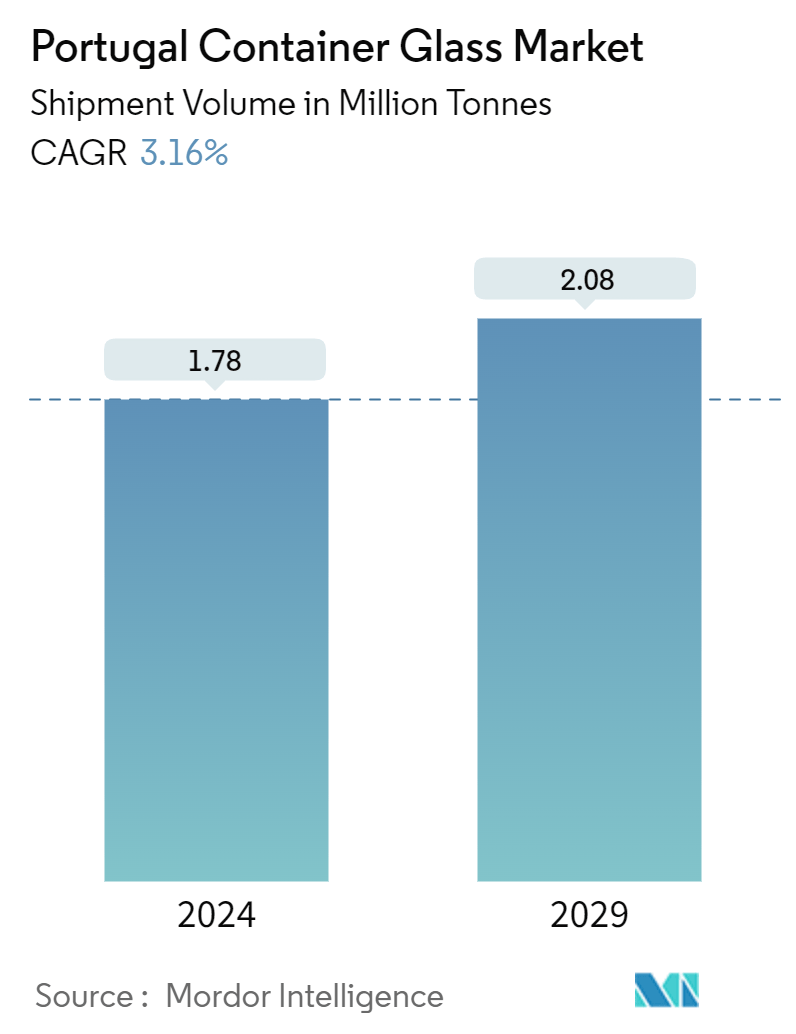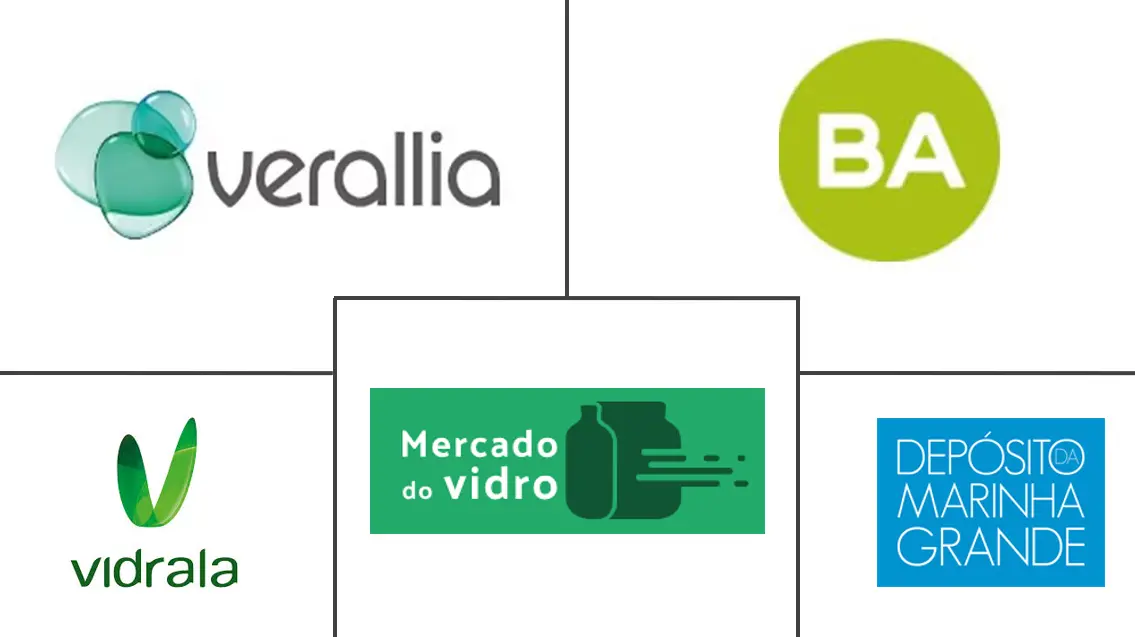Market Size of Portugal Container Glass Industry

| Study Period | 2019 - 2029 |
| Base Year For Estimation | 2023 |
| Market Volume (2024) | 1.78 Million tonnes |
| Market Volume (2029) | 2.08 Million tonnes |
| CAGR (2024 - 2029) | 3.16 % |
| Market Concentration | High |
Major Players
*Disclaimer: Major Players sorted in no particular order |
Portugal Container Glass Market Analysis
The Portugal Container Glass Market size in terms of shipment volume is expected to grow from 1.78 Million tonnes in 2024 to 2.08 Million tonnes by 2029, at a CAGR of 3.16% during the forecast period (2024-2029).
- According to the European Union economic forecast, Portugal's economy experienced a growth of 2.3 percent in 2023. Due to weak demand from key trading partners, economic growth is expected to remain subdued at the start of 2024, with only a gradual pickup anticipated thereafter. With vineyards boasting a history of over 4,000 years, Portugal's rich wine-producing heritage plays a pivotal role in driving the demand for container glass.
- In Portugal, a rising demand for sustainable packaging has led many end users to increasingly adopt container glass. European manufacturers, like BA Vidro S.A., which has operations in Portugal, cater primarily to the food and beverage sector. Operating across multiple European nations, they produce a staggering 9 billion containers annually, significantly fueling Portugal's market growth.
- As alcohol consumption continues to rise in Portugal, it's set to further bolster the glass container market. Tinted amber glass containers, favored for alcoholic beverages, provide essential UV radiation protection. Moreover, the demand for clear glass containers is projected to surge at an even faster pace in the upcoming years. Data from Statistics Portugal highlights a notable increase in wine consumption per capita, jumping from 42.5 liters in 2020 to 52.5 liters in 2023, underscoring the heightened demand for container glass.
- Furthermore, the pharmaceutical industry's increasing reliance on glass containers in Portugal is propelling market growth. These pharmaceutical glass containers are crafted to stringent tolerance limits, given their use in high-speed filling lines. Compared to polyethylene terephthalate (PET), glass containers are deemed more environmentally friendly, having a lesser impact on both the environment and human health.
- On the flip side, the rising adoption of alternative products, such as metal and reusable plastic, poses a challenge to the growth of the glass container market. While plastic remains a dominant packaging choice in Portugal due to its energy-efficient transport, glass's fragility necessitates additional protective packaging during transit, a factor that could potentially limit its market expansion in the country.
Portugal Container Glass Industry Segmentation
Container glass is designed for crafting glass containers, including bottles, jars, drinkware, and bowls. Its key attributes include chemical inertness, sterility, and non-permeability, rendering it especially sought after in the beverage, food, pharmaceutical, and cosmetic sectors. The research also examines underlying growth influencers and significant industry vendors, all of which help to support market estimates and growth rates throughout the anticipated period. The market estimates and projections are based on the base year factors and arrived at top-down and bottom-up approaches.
Portugal Container Glass Market is segmented by end-user industry ((Beverages (Alcoholic Beverages (beer and cider, wine and spirits and other alcoholic beverages) and Non-Alcoholic Beverages (carbonated soft drinks, juices, water and other non-alcoholic beverages)), food, cosmetics, pharmaceutical and other end-user industries). The market sizes and forecasts are provided in terms of volume (Tonnes) for all the above segments.
| By End-User Industry | ||||||||||||
| ||||||||||||
| Food | ||||||||||||
| Cosmetics | ||||||||||||
| Pharmaceutical (Excluding Vials and Ampoules) | ||||||||||||
| Other End-User Industries |
Portugal Container Glass Market Size Summary
The Portugal container glass market is experiencing growth driven by the increasing demand for sustainable packaging solutions, particularly due to the ban on single-use plastics. This shift towards eco-friendly and reusable options like glass is gaining traction among various end users. The pharmaceutical industry is a significant contributor to this demand, as glass containers are preferred for medicinal packaging due to their environmental benefits over alternatives like PET. Additionally, the rising consumption of alcoholic beverages is expected to further boost the market, with tinted amber glass containers being favored for their UV protection. However, the market faces challenges from the growing use of metal and reusable plastic substitutes, which could hinder its expansion.
The market's growth is also supported by the increasing production and export of beverages, spirits, and vinegar, which necessitates the use of container glass for packaging. Health trends in Europe are driving demand for products like flavored sparkling water and fruit juices, contributing to market expansion. Despite low recycling levels in Portugal, initiatives like the iREC project aim to enhance recycling efforts, potentially influencing future glass container usage. The pharmaceutical sector remains stable, with significant sales and exports, further supporting the market. The fragmented nature of the market sees regional and local players actively participating in recycling projects to improve glass packaging recycling rates in the country.
Portugal Container Glass Market Size - Table of Contents
-
1. MARKET INSIGHTS
-
1.1 Market Overview
-
1.2 Import Export Data of Container Glass
-
1.3 PESTLE Analysis
-
1.4 Industry Standards and Regulations for Container Glass Use for Packaging
-
1.5 Raw Material Analysis & Material Considerations for Packaging
-
1.6 Sustainability Trends for Packaging
-
1.7 Container Glass Furnace Capacity and Location in Portugal**
-
-
2. MARKET SEGMENTATION
-
2.1 By End-User Industry
-
2.1.1 Beverage
-
2.1.1.1 Alcoholic Beverages
-
2.1.1.1.1 Beer and Cider
-
2.1.1.1.2 Wine and Spirits
-
2.1.1.1.3 Other Alcoholic Beverages
-
-
2.1.1.2 Non-Alcoholic Beverages
-
2.1.1.2.1 Carbonated Soft Drinks
-
2.1.1.2.2 Juices
-
2.1.1.2.3 Water and Other Non-Alcoholic Beverages
-
-
-
2.1.2 Food
-
2.1.3 Cosmetics
-
2.1.4 Pharmaceutical (Excluding Vials and Ampoules)
-
2.1.5 Other End-User Industries
-
-
Portugal Container Glass Market Size FAQs
How big is the Portugal Container Glass Market?
The Portugal Container Glass Market size is expected to reach 1.78 million tonnes in 2024 and grow at a CAGR of 3.16% to reach 2.08 million tonnes by 2029.
What is the current Portugal Container Glass Market size?
In 2024, the Portugal Container Glass Market size is expected to reach 1.78 million tonnes.

